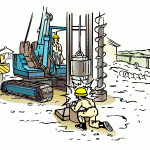October 29th, 2008 by Frank LaBanca, Ed.D.
I am in the process of writing a manuscript about 21st-century learning and the integration of technology. I have developed a three-tiered system to identify types of learning activities that integrate technology. Their descriptions are provided below. Can you help me by providing practical examples from the classroom of the different technology integrations? Your comments would be greatly appreciated.
 Retrofitting
Retrofitting
The simplest integration of technology into teaching and learning is retrofitting. There is little change in instruction, but rather a different tool is used to facilitate similar learning strategies. This level of implementation has the instructor performing the same tasks, with the same teaching and learning strategies, only using the technology as a new tool. The teacher still delivers information directly to students and may have interaction via questioning. The use of the technology does not intellectually challenge students in any new or novel format. Instruction, although perhaps enhanced in some fashion, really is not altered in any meaningful way.
 Retooling
Retooling
The next level of information technology integration offers educators more tools for learning. Retooling expands options for learning. For example, instead of being limited by the books available in a classroom or library, a virtual world of extensive, seemingly endless information becomes available using online tools. The information is generally available upon demand and is easily cross-referenced and verified by a cautious, critical eye. Although there is an increase in options for knowledge acquisition, there is still only a one way flow of learning: from source to student. Educators have the ability to do more to enhance student learning.
 Reconfiguring
Reconfiguring
When truly considering the implementation of twenty-first-century skills in conjunction with core instruction, educators must reconfigure. Most recognize that constructivist-based knowledge acquisition occurs through a situated learning schema where students not only learn from the “Sage” (whether the Sage be a teacher or a website), but from social interaction with one another. Knowledge flow can occur in two directions. Therefore, students need to become producers of information, not just consumers. Implementing novel knowledge production in this bidirectional fashion certainly will cause changes to teacher pedagogy. It is probable that many educators will need direct and specific training and mentoring to implement this type of change.
Many web-based tools are specifically designed with interactive features. Sometimes dubbed Web 2.0 or the read/write web, these sites allow simple production and the ability for others to provide reactions or comments. Blogs, wikis, podcasts, discussion forums, photo albums, instant messaging, and voicethreads allow students to produce original work, publish it online, and solicit feedback from other classmates, the teacher, or the online world in general. Student-producers do not have to be savvy at programming. Rather, the web tools are menu driven, object-oriented, and often have interfaces that look like common word processing software packages. This is important because it allows students and teachers to focus on content, concepts, and ideas, not the distracting minutia of web coding.